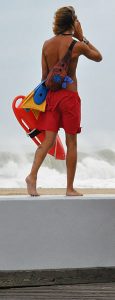
IoT Augmented Swim Safety: Lifeguard Sensing and Attunement
By tying the WAVE DDS sensors and the Cassia long-range gateways to a larger back-end system with flashing alarms, bracelet vibrations for lifeguards, etc…via the Cassia AC, the WAVE DDS serves as a safety back up system for lifeguards. It doesn’t replace, but rather enhances and supports the capabilities of lifeguard staff, camp counselors, and other swimming supervisors. Moreover, potentially hazardous swim-related “risk events,” which previously may have been missed entirely, are now tracked as data and better understood.
With more data, lifeguards can “attune” the practice of lifeguarding in alignment to the actual risks in a swim environment. For example, as “risk” event data is gathered, certain areas of the swim venue or times of the day, or populations, may be understood to have higher risk characteristics. In turn, lifeguarding resources and attention are employed and directed to greater effect and with greater efficiency.
Passively Active Bluetooth IoT: Flexible Swim Safety Systems and Real-Time Training
As noted previously, the trackers are non-invasive, unobtrusive wearables. The tracker works in the background as a passive system, augmenting standard active lifeguarding activities.
Moreover, several trends in swimming venues support the use of added passive systems of sensory augmentation for swimming safety and specifically the use of Bluetooth IoT. For example, there is a trend towards larger “experiential” low depth suburban or urban swimming areas with splash pools and other “fun” features, like slides and sprays. These added features alter sightlines and cast shadows which can confuse acoustic and video swim-safety systems. Bluetooth IoT, however, is not impacted by these and other natural conditions in swim environments, like sun glare, dark skies, reflections, water flow, vegetation, and motor boat sounds.
Moreover, the WAVE DDS is easy to install out-of-the-box because a wireless Bluetooth-based system is not hampered by the elaborate installation processes of other wired systems. As Cassia Networks CEO, Felix Zhao, has noted the most successful IoT solutions are “easy to use,” as well as “real-time, reliable, and scalable” and not mediated by or dependent on human senses. Also, a Bluetooth system, like WAVE DDS, is flexible. It will not require a re-wiring at the swim facilities when, for example, the remodeling of a swimming building occurs.
Instead, the vibration of the lifeguard bracelets signal a swimmer is in a “risk zone” and can help attune to “potential” swimming events so they are focus their attention to actual near-drowning events with more acuity and speed. In this way, the sensory enhancement provided by WAVE DDS’s Bluetooth IoT helps to train lifeguards attention to situations where swimmers are at risk.
IoT Ripple Effects: Safety results, data sets, and industry
Life guards are focused on preventing drownings and the history of lifeguarding includes a long history of adding tools, like toss buoy’s swimmers hooks, even anti-glare sunglasses extending and enhancing their capabilities. It’s important that any safety system is accepted by its users, whether it’s a swim safety Bluetooth IoT beacon or a safety belt in a car.

As with seat belts, historical data results as well as the normalization of using a safety belt drove a discussion and eventually policy decisions and widespread social acceptance.
Similarly, with a passive, unobtrusive Bluetooth system and wearable, a normalization occurs when a swim safety system does not interfere with enjoyment of swimming while helping to mitigate the risk of a drowning. Wearables too, and the sensory augmentation they deliver, is fast becoming normalized in society.
Because of the WAVE DDS tracker’s light weight design, it stays on, and is comfortable. Moreover, with the addition of the Cassia long-range, multiple connections Bluetooth capabilities the back-end wireless system supporting and supplementing the lifeguard’s work, is cost effective and flexible.
Ultimately, an IoT safety system has a ripple effect in the entire industry where it is deployed. For example, as the WAVE DDS is deploying nationwide, a widening conversation about how this type of IoT safety system may impact insurance premiums at swimming venues is underway.
Currently, safety data is gathering based on the use of the WAVE DDS at swimming venues. Also, safety data from the WAVE DDS itself is driving discussions and decisions regarding insurance premiums, lifeguard staffing, types of swimming venues and features within those swimming venues relative to safety.
References
Office of the Associate Director for Communication, Digital Media Branch, Division of Public Affairs, June, 2012 Centers for Disease Control and Prevention, Drowning Risks in Natural Water Settings
https://www.cdc.gov/Features/dsDrowningRisks/
Click here for PART 1…







